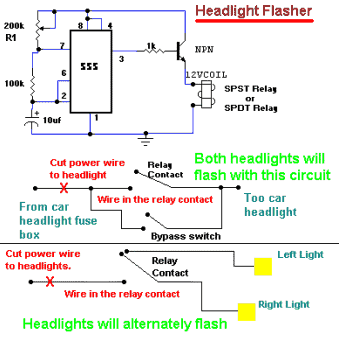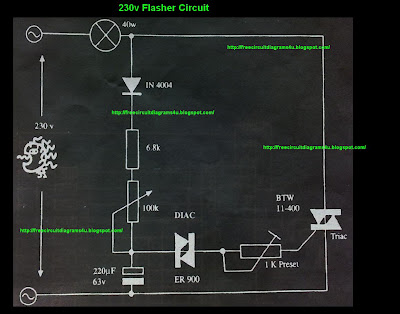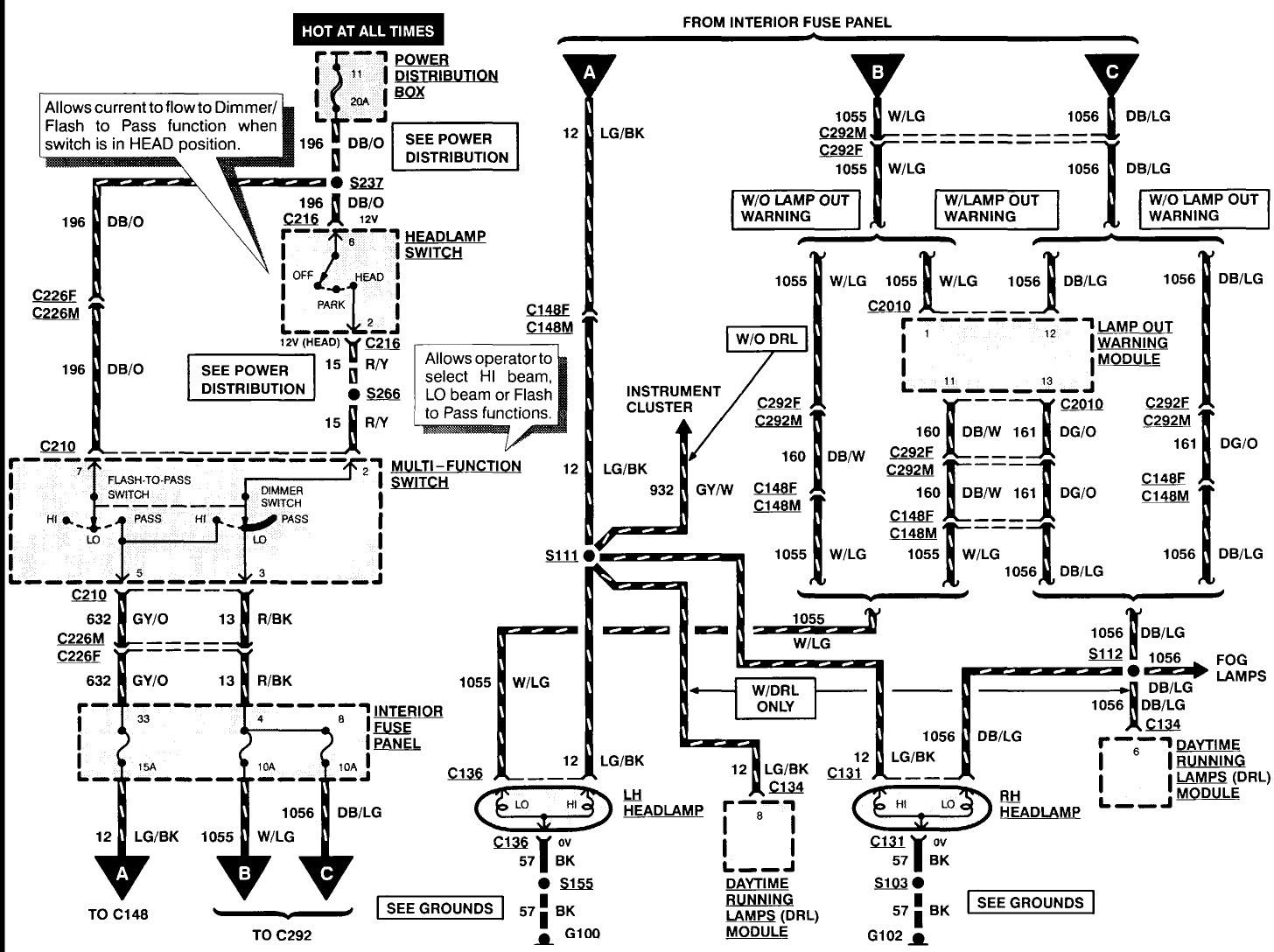
Headlight Flasher

This circuit enables car headlights to flash on and off simultaneously or alternately. It is based on the 555 timer operating in astable mode. The output of the 555 timer will go high for an adjustable period and then turn off, repeating this cycle. The duration is adjustable via resistor R1. To connect the circuit to a vehicle, locate the positive wire from the fuse box to the headlights, cut the wire, and insert the relay contact and bypass switch. The bypass switch allows for normal headlight operation by bypassing the relay contact. For the alternating headlight configuration, the positive wire to each headlight must be cut, and the relay contact wired in.
The circuit utilizes a 555 timer IC configured in astable mode, which is ideal for generating a square wave output. This mode allows the circuit to toggle the headlights between on and off states at a frequency determined by the external resistors and capacitors connected to the timer. The timing period can be modified by adjusting resistor R1, which influences the charge and discharge cycles of the timing capacitor, thereby controlling the flash rate of the headlights.
To implement this circuit within a vehicle, the first step involves identifying the positive wire leading from the fuse box to the headlights. This wire must be severed to integrate the circuit. The relay contact is then introduced into the circuit, allowing the 555 timer to control the power supplied to the headlights. The bypass switch is an essential component, as it permits the driver to revert to standard headlight functionality without engaging the flashing feature. This is particularly useful during regular driving conditions when continuous illumination is required.
For the alternating headlight configuration, the installation process requires cutting the positive wire that leads to each headlight separately. This modification allows the circuit to alternate the activation of each headlight, creating a distinctive flashing effect that can enhance visibility and attention in various driving situations. Proper connection and insulation of all wires and components are crucial to ensure safety and reliability in operation. Additionally, it is recommended to use a relay rated for the current and voltage specifications of the vehicle's headlight system to prevent overheating and potential failure.It will allow your car headlights to flash on and off at the same time or it will cause them to flash alternately. The circuit is based on the 555 timer. It is used in the astable mode. The 555 timer output will go high for an adjustable period of time and then turn off. It will then repeat the procedure. The time is adjusted by R1. To hook up the circuit to your car you must locate the positive wire from the fuse box to the headlights. Cut the wire and insert the relay contact and bypass switch. The bypass switch will allow you to bypass the relay contact for normal headlight operation. In the alternateing headlight configuration you must cut the positive wire to each headlight and wire in the relay contact.
🔗 External reference
The circuit utilizes a 555 timer IC configured in astable mode, which is ideal for generating a square wave output. This mode allows the circuit to toggle the headlights between on and off states at a frequency determined by the external resistors and capacitors connected to the timer. The timing period can be modified by adjusting resistor R1, which influences the charge and discharge cycles of the timing capacitor, thereby controlling the flash rate of the headlights.
To implement this circuit within a vehicle, the first step involves identifying the positive wire leading from the fuse box to the headlights. This wire must be severed to integrate the circuit. The relay contact is then introduced into the circuit, allowing the 555 timer to control the power supplied to the headlights. The bypass switch is an essential component, as it permits the driver to revert to standard headlight functionality without engaging the flashing feature. This is particularly useful during regular driving conditions when continuous illumination is required.
For the alternating headlight configuration, the installation process requires cutting the positive wire that leads to each headlight separately. This modification allows the circuit to alternate the activation of each headlight, creating a distinctive flashing effect that can enhance visibility and attention in various driving situations. Proper connection and insulation of all wires and components are crucial to ensure safety and reliability in operation. Additionally, it is recommended to use a relay rated for the current and voltage specifications of the vehicle's headlight system to prevent overheating and potential failure.It will allow your car headlights to flash on and off at the same time or it will cause them to flash alternately. The circuit is based on the 555 timer. It is used in the astable mode. The 555 timer output will go high for an adjustable period of time and then turn off. It will then repeat the procedure. The time is adjusted by R1. To hook up the circuit to your car you must locate the positive wire from the fuse box to the headlights. Cut the wire and insert the relay contact and bypass switch. The bypass switch will allow you to bypass the relay contact for normal headlight operation. In the alternateing headlight configuration you must cut the positive wire to each headlight and wire in the relay contact.
🔗 External reference





